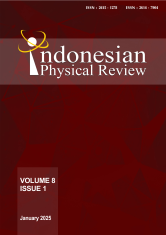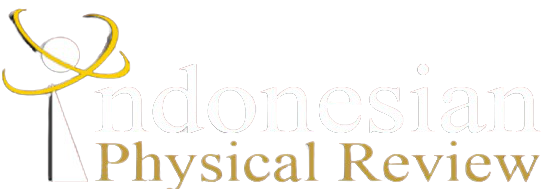OPTIMIZING ELECTRON DIFFUSION, TEMPERATURE, AND PHOTOANODE THICKNESS FOR ENHANCED PHOTOVOLTAIC EFFICIENCY IN TiOâ‚‚/CuS DYE-SENSITIZED SOLAR CELLS (DSSCs)
DOI:
10.29303/ipr.v8i1.413Downloads
Abstract
This study addresses a critical gap in optimizing electron diffusion, operational temperature, and photoanode thickness to enhance the photovoltaic efficiency of TiOâ‚‚/CuS-doped dye-sensitized solar cells (DSSCs). While previous studies have investigated individual parameters affecting DSSC performance, limited research examines their combined effects on charge transport and recombination rates. Through computational modeling, we evaluated photoanode thicknesses from 1 µm to 100 µm and operational temperatures from 260 K to 350 K, analyzing their influence on electron mobility, recombination rates, and overall efficiency. Results show that the electron diffusion coefficient increases with temperature, reaching a maximum of 1.626 × 10â»â¶ cm²/s at 350 K, thereby enhancing electron transport and reducing recombination losses. An optimal photoanode thickness of 3 µm was identified, yielding the highest efficiency of 17.28% across the temperature range. Efficiency declines at thicknesses exceeding 3 µm due to extended electron diffusion paths and higher recombination rates. These findings underscore the importance of balancing temperature and structural parameters to improve charge transport and minimize losses, particularly for DSSC applications in warm environments.
Keywords:
DSSC TiO2/CuS electron diffusion temperature photoanode thickness efficiency optimizationReferences
A. Daniswara, G. Raydiska, and Y. Timotius, “Strategi Implementasi Dye Sensitized Solar Cell (DSSC) di Indonesia,†2020.
S. S. Mehendre, M. D. Mahajan, S. V Gaikwad, and S. B. Thosare, “Use of Solar Energy in Electricity Generation,†Sci. Technol., vol. 1, no. 9, 2021, [Online]. Available: http://www.ijodst.com/http://www.ijodst.com/
M. Grätzel, “Mesoscopic solar cells for electricity and hydrogen production from sunlight,†Chemistry Letters, vol. 34, no. 1. pp. 8–13, Jan. 05, 2005. doi: 10.1246/cl.2005.8.
J. Gong, K. Sumathy, Q. Qiao, and Z. Zhou, “Review on dye-sensitized solar cells (DSSCs): Advanced techniques and research trends,†Renewable and Sustainable Energy Reviews, vol. 68. Elsevier Ltd, pp. 234–246, Feb. 01, 2017. doi: 10.1016/j.rser.2016.09.097.
J. E. Suseno, A. Y. Wardaya, and A. Khumaeni, “Fabrication and properties of high efficiency dye-sensitized solar cells (DSSCs) with photon absorption optimization,†J. Phys. Conf. Ser., vol. 1524, no. 1, 2020, doi: 10.1088/1742-6596/1524/1/012027.
S. Demic, A. N. Ozcivan, M. Can, C. Ozbek, and M. Karakaya, “Recent Progresses in Perovskite Solar Cells,†Nanostructured Sol. Cells, 2017, doi: 10.5772/65019.
S. A. Olaleru, J. K. Kirui, D. Wamwangi, K. T. Roro, and B. Mwakikunga, “Perovskite solar cells: The new epoch in photovoltaics,†Sol. Energy, vol. 196, no. July 2019, pp. 295–309, 2020, doi: 10.1016/j.solener.2019.12.025.
K. M. Lee, V. Suryanarayanan, and K. C. Ho, “A study on the electron transport properties of TiO2 electrodes in dye-sensitized solar cells,†Sol. Energy Mater. Sol. Cells, vol. 91, no. 15–16, pp. 1416–1420, 2007, doi: 10.1016/j.solmat.2007.03.007.
N. A. Karim, U. Mehmood, H. F. Zahid, and T. Asif, “Nanostructured photoanode and counter electrode materials for efficient Dye-Sensitized Solar Cells (DSSCs),†Sol. Energy, vol. 185, no. January, pp. 165–188, 2019, doi: 10.1016/j.solener.2019.04.057.
E. Supriyanto, M. Nawafil, and A. Subekti, “Optimizing dye-sensitized solar cell efficiency through TiO2/CuS doping: effects of internal parameter variations,†Eastern-European J. Enterp. Technol., vol. 5, no. 4, pp. 6–13, 2024, doi: 10.15587/1729-4061.2024.310454.
A. Aboulouard, “Effect of Temperature and Electrode Thickness on the Performance of Dye-Sensitized Solar Cells,†Phys. Chem. Res., vol. 10, no. 1, pp. 23–30, 2022, doi: 10.22036/PCR.2021.289185.1921.
E. Supriyanto, N. Alviati, H. A. Kartikasari, L. Rohman, and K. Triyana, “Simulation of Electron Diffusion Coefficient Interpretation on the Optimum Thickness of TiO2 Photoanode in Dye-Sensitized Solar Cell (DSSC),†in IOP Conference Series: Materials Science and Engineering, Institute of Physics Publishing, 2019. doi: 10.1088/1757-899X/515/1/012058.
A. Aboulouard, A. Jouaiti, and B. Elhadadi, “Modelling and Simulation of the Temperature Effect in Dye Sensitized Solar Cells,†Der Pharma Chem., vol. 9, no. 21, pp. 94–99, 2017.
J. Gong and K. Sumathy, “A theoretical study on third generation photovoltaic technology: Dye-sensitized solar cells,†Renew. Energy Power Qual. J., vol. 1, no. 10, pp. 157–160, 2012, doi: 10.24084/repqj10.256.
D. M. Atia and N. M. Ahmed, “Mathematical modeling, parameter identification, and electrical performance of a DSSC based on nature-inspired optimization techniques,†J. Comput. Electron., vol. 22, no. 2, pp. 723–741, 2023, doi: 10.1007/s10825-023-02018-8.
E. Supriyanto, L. Ni’mah, S. Sujito, N. Alviati, A. Dikayanti, and A. G. E. Sutjipto, “Optimization of TiO2/Ag Photoanode Thickness for Improvement Dye-Sensitized Solar Cell (DSSC) Performance With Simulation Method,†AIP Conf. Proc., vol. 2682, no. February, 2023, doi: 10.1063/5.0118273.
A. A. El Tayyan, “Dye-Sensitized solar cell: Parameters calculation and model integration,†J. Electron Devices, vol. 11, pp. 616–624, 2011.
S. Handayani and A. Haris, “Pengaruh Pasta ZnO dengan Penambahan Dish Detergent dan PVA pada Kaca Konduktif terhadap Efisiensi Dye Sensitized Solar Cell dari Ekstrak Bunga Rosela (Hibiscus sabdariffa L.),†J. Sci. Appl. Chem., 2013.
M. Das, D. Das, S. Sil, and P. P. Ray, “Development of hierarchical copper sulfide-carbon nanotube (CuS-CNT) composites and utilization of their superior carrier mobility in efficient charge transport towards photodegradation of Rhodamine B under visible light,†Nanoscale Adv., vol. 5, no. 14, pp. 3655–3663, 2023, doi: 10.1039/d3na00204g.
L. Safriani and R. Rahmadani, “Efek Penambahan rGO Pada Fotoanoda Tio2 Terhadap Performa Sel Surya Tersensitasi Dye,†J. Mater. dan Energi Indones., vol. 11, no. 01, p. 01, 2021, doi: 10.24198/jme.v11i01.35039.
M. Dhonde, K. Sahu, V. V. S. Murty, S. S. Nemala, and P. Bhargava, “Surface plasmon resonance effect of Cu nanoparticles in a dye sensitized solar cell,†Electrochim. Acta, 2017, doi: 10.1016/j.electacta.2017.07.187.
M. Dhonde, K. Sahu, V. V. S. M. Siva, S. Nemala, P. Bhargava, and S. Mallick, “Enhanced photovoltaic performance of a dye sensitized solar cell with Cu / N Co-doped  TiO 2 nanoparticles,†J. Mater. Sci. Mater. Electron., vol. 0, no. 0, p. 0, 2018, doi: 10.1007/s10854-018-8605-3.
L. M. Herz, “Charge-Carrier Mobilities in Metal Halide Perovskites: Fundamental Mechanisms and Limits,†ACS Energy Lett., vol. 2, no. 7, pp. 1539–1548, 2017, doi: 10.1021/acsenergylett.7b00276.
H. Seo, S. H. Nam, N. Itagaki, K. Koga, M. Shiratani, and J. H. Boo, “Effect of sulfur doped TiO2 on photovoltaic properties of dye-sensitized solar cells,†Electron. Mater. Lett., vol. 12, no. 4, pp. 530–536, 2016, doi: 10.1007/s13391-016-4018-8.
D. Sengupta, P. Das, B. Mondal, and K. Mukherjee, “Effects of doping, morphology and film-thickness of photo-anode materials for dye sensitized solar cell application - A review,†Renew. Sustain. Energy Rev., vol. 60, pp. 356–376, 2016, doi: 10.1016/j.rser.2016.01.104.
S. M. R. Nadeak and D. Susanti, “variasi temperatur dan waktu tahan kalsinasi terhadap unjuk kerja semikonduktor TiO2 sebagai dye sensitizer solar cell (DSSC) dengan dye dari ekstrak buah naga merah,†J. Tek. Pomits, vol. 1, no. 1, pp. 81–86, 2012.
License

This work is licensed under a Creative Commons Attribution-NonCommercial-ShareAlike 4.0 International License.
Authors who publish with Indonesian Physical Review Journal, agree to the following terms:
- Authors retain copyright and grant the journal right of first publication with the work simultaneously licensed under a Creative Commons Attribution-ShareAlike 4.0 International Licence (CC BY SA-4.0). This license allows authors to use all articles, data sets, graphics, and appendices in data mining applications, search engines, web sites, blogs, and other platforms by providing an appropriate reference. The journal allows the author(s) to hold the copyright without restrictions and will retain publishing rights without restrictions.
- Authors are able to enter into separate, additional contractual arrangements for the non-exclusive distribution of the journal's published version of the work (e.g., post it to an institutional repository or publish it in a book), with an acknowledgment of its initial publication in Indonesian Physical Review Journal.
- Authors are permitted and encouraged to post their work online (e.g., in institutional repositories or on their website) prior to and during the submission process, as it can lead to productive exchanges, as well as earlier and greater citation of published work (See The Effect of Open Access).





